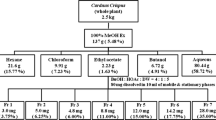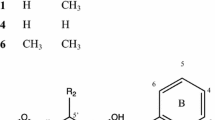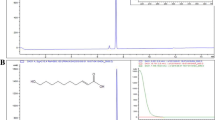Abstract
A methanolic extract of Costus pictus (CPME) showed optimum anti-diabetic activity at 100 ng/ml. Bioactivity-guided purification of CPME led to the isolation of methyl tetracosanoate (MT) which showed an optimum glucose uptake at 1 ng/ml. CPME at 10 μg/ml inhibited adipogenesis whereas fully differentiated adipocytes exhibited a 3-fold increase in lipid accumulation compared to pre-adipocytes. Gene and protein expression of key targets in insulin signaling and adipogenesis pathway revealed that CPME exhibited anti-diabetic activity along with anti-adipogenic activity whereas MT demonstrated only anti-diabetic activity.
Similar content being viewed by others
Avoid common mistakes on your manuscript.
Introduction
Type 2 diabetes, characterized by insulin resistance, is caused largely due to obesity, affecting around 80% of the entire diabetic population. Increasing knowledge on the biochemical and cellular alterations occurring in diabetes has led to the development of novel and potentially more effective therapeutic approaches to treat this metabolic disorder. Many pharmaceutical companies also pursue drug discovery using natural products, as traditional knowledge follows a reverse path which helps reduce time and developmental cost (Jachak and Saklani 2007). The reverse path is advantageous in elucidating drug targets and helps in identification of bioactive molecule. Metformin is one such commercially available anti-diabetic drug derived from Galega officinalis.
The present study focuses on identifying an anti-diabetic molecule from Costus pictus belonging to the family of Zingiberaceae and mostly grown as an ornamental plant in many countries (Meléndez-Camargo et al. 2006). This plant has hypoglycemic activity and can regenerate beta cells of pancreatic islets (Jothivel et al. 2007). The existing challenge is to study the role of Costus pictus methanolic extract (CPME) and the isolated bioactive molecule on key regulators involved in the process of glucose uptake and adipogenesis, using an in vitro model.
Materials and methods
Process of extraction
Costus pictus leaves were shade dried and extracted using methanol yielding methanolic extract (CPME), which was concentrated under reduced pressure.
Measurement of 2-deoxy-d-[1-3H]glucose
3T3-L1 preadipocytes, grown in 24-well plate were differentiated to adipocytes and were incubated with the plant extracts, column fractions or bioactive molecule and were subjected to glucose uptake assay using radiolabelled 2-deoxy-d-[1-3H]glucose (Muthusamy et al. 2008).
Isolation and purification of bioactive fraction
A column (5 cm × 25 cm) was packed using silica gel (60–120 mesh) in hexane. The ratio of the extract slurry loaded to silica gel was 1:20 (w/w) (using 2 g plant material). The column was eluted by an increasing polarity of the mobile phase solvent mixture hexane/ethyl acetate (100:0, 95:5 to 0:100 v/v), elution was continued in the same column using ethyl acetate/methanol (95:5 to 0:100 v/v) with 25 ml eluate being collected per test-tube. Fractions were concentrated under reduced pressure and pooled based on their TLC fingerprint. The pooled fractions were tested for bioactivity and the bioactive fraction was further purified using second stage column (2 cm × 25 cm) packed with 100–200 mesh silica gel and the obtained fractions were again subjected to bioassay for the determination of the bioactive molecule.
PTP1B inhibition study
The phosphatase activity was assayed using 20 mM p-nitrophenyl phosphatase (pNPP) as substrate and carried out in sodium acetate buffer, in a 96-well format (Burke et al. 1996). The reaction was initiated by the addition of recombinant PTP1B enzyme (Biomol Research Laboratories, Inc., PA, USA) into CPME, MT and sodium orthovanadate pre-treated wells (100 ng/ml, 1 ng/ml and 100 μM, respectively) and incubated for 30 min at 37°C. The rate of PTP1B-catalyzed hydrolysis of substrate was measured at an absorbance of 405 nm.
Adipocyte differentiation assay
The ability of 3T3-L1 preadipocyte to differentiate in the presence of plant extract and bioactive molecule were assessed at varying concentrations (1 ng/ml to 10 μg/ml) over untreated cells by measuring the accumulation of triglycerides (Ambati et al. 2007). Triglyceride content was measured using AdipoRed assay kit.
Lactate dehydrogenase release (LDH) assay for cell death
CPME and MT were assessed for cytotoxicity at 10 μg/ml. The LDH released was measured using the CytoTox 96 (TM) assay (Muthusamy et al. 2008). Triton X was used as positive control.
Isolation of total RNA and RT-PCR
Cells were co-incubated with optimized concentrations of CPME and MT for 18 h and then homogenized using TRIzol reagent. Isolated RNA was converted to cDNA by reverse transcription (Chomczynski and Sacchi 1987) and cDNA was subjected to PCR with specific primers such as GAPDH, GLUT 4, PPARγ, C/EBPα, SREBP 1c, adiponectin.
Western blot analysis
Total cell lysates were prepared (Klip et al. 1992) and total protein was estimated using Bradford’s method. Equal quantities of protein samples were loaded for carrying out western blot analysis.
Statistical analysis
All experiments were carried out at least twice in triplicates and data were expressed as mean ± SE of independent experiments. Mean difference between the groups was analyzed by one-way analysis of variance (using GraphPad Prism 5). P < 0.05 was considered as statistically significant and are indicated as (*).
Results and discussion
3T3-L1 adipocytes were used as a model system since adipocytes mimic fat cells, inducing insulin resistance which is the major contributor of type 2 diabetes (Guilherme et al. 2008). The methanolic extract of Costus pictus (CPME) was subjected to primary screening to evaluate its anti-diabetic activity. CPME at 100 ng/ml showed an optimum glucose uptake (Table 1) when compared with rosiglitazone (positive control).
Based on the anti-diabetic activity exhibited by CPME, it was subjected to bioactivity guided purification using conventional column chromatography. The bioactive compound eluted in hexane: ethyl acetate system between ratios of 75:25 (v/v) to 60:40 (v/v) and exhibited an optimum activity at 1 ng/ml (Table 1). The bioactive compound when subjected to glucose uptake assay at lower concentrations such as 100 pg/ml, 10 pg/ml and 1 pg/ml showed a decreased glucose uptake in a dose dependent manner (data not shown). This could be due to saturation limit of the isolated bioactive compound, which was attained at 1 ng/ml and therefore an increase or decrease in concentration did not exert any increment in glucose uptake.
The purified compound showing optimal activity was subjected to gas chromatography mass spectrometry (GCMS) and proton nuclear magnetic resonance spectroscopy (1H NMR) respectively (Supplementary Fig. 1). The data obtained when compared with SDBS database, revealed that the compound was methyl tetracosanoate (MT) (SDBS No.: 7702; CID: 75546), which is also known as methyl lignocerate, a saturated fatty acid. The molecular formula of the compound was found to be CH3 (CH2)22 COOCH3.
CPME and MT were non-cytotoxic on 3T3-L1 adipocytes (data not shown). Optimum concentrations of CPME (100 ng/ml) and MT (1 ng/ml) were used for further studies to decipher their mechanistic role in activating key diabetic markers like protein tyrosine phosphatase 1B (PTP1B), insulin receptor β (IRβ), phosphotidylinositol 3 kinase (PI3K), peroxisome proliferator-activated receptor (PPARγ) and glucose transporter 4 (GLUT4).
The translocation of GLUT4 is hindered due to increased PTP1B levels resulting in dephosphorylation of IR and IRS-1 thereby retaining PI3K in an inactive state (non-phosphorylated) under insulin resistant conditions (Wu et al. 2005; Laukkanen et al. 2004). CPME and MT showed 76 ± 4% and 76 ± 5% inhibition of PTP1B enzyme respectively and the positive control, sodium orthovanadate (100 μM) showed 96 ± 5% of PTP1B inhibition.
CPME and MT treated cells were found to elevate the GLUT4 mRNA expression compared to the positive controls (Fig. 1). Cells upon treatment with CPME and MT were found to show IRβ and PI3K protein expressions equivalent to that of positive controls (Fig. 2). The effect of CPME and MT on PPARγ mRNA expression was analyzed, since PPARγ agonists act as insulin sensitizers in resistant tissues (Cho et al. 2008). Activation of PPARγ has been found to influence insulin signaling at various points including the p85 subunit of PI3K (Chuang et al. 2007) which has been reported for enhancement of GLUT4 activity (Sandouk et al. 1993). Cells treated with MT at 18 h exhibited PPARγ expression on par with rosiglitazone (50 μM) whereas CPME exhibited basal level expression (Fig. 1) (Yang et al. 2001). Although increased levels of PPARγ exhibits insulin sensitization, this target is over-expressed in obese conditions and its suppression acts as a potential treatment for type 2 diabetes caused due to obesity (Spiegelman and Flier 1996).
Effect of Costus pictus methanolic extract (CPME) and methyl tetracosanoate (MT) on GLUT4 and PPARγ mRNA transcripts. 3T3-L1 adipocytes were incubated with insulin (100 nM) for 15 min and rosiglitazone (50 μM), CPME (100 ng/ml) and MT (1 ng/ml) for 18 h. Lane 1–6 indicates untreated control, insulin, rosiglitazone, CPME, MT treated cells and PCR negative control, respectively. The expression levels of GLUT4 transcripts (318 bp) were compared with control cells. CPME and MT showed expression similar to the positive controls, Insulin and Rosiglitazone. The levels of PPARγ (155 bp) in CPME treated cells showed basal level expression whereas MT treated cells showed increased expression as compared to rosiglitazone, the positive control. The mRNA of GAPDH (316 bp) in the same sample was used as a loading reference
Effect of Costus pictus methanolic extract (CPME) (100 ng/ml) and methyl tetracosanoate (MT) (1 ng/ml) on IRβ and PI3K expression. Equal quantities of protein samples were loaded and resolved in 10% SDS–PAGE. Proteins were transferred onto nitrocellulose membrane. The membrane was blocked with (5% w/v) skimmed milk powder as the blocking agent for overnight at 4°C followed by 1 h incubation with the primary antibody (1:2000 of anti-phospho IRβ/p85 PI3K antibody (BD Pharmingen)). After PBS washing and secondary antibody (ALP conjugate) incubation, the blot was visualized using NBT/BCIP chromogenic agent and photographed. Lane 1–5 indicates untreated control, insulin, rosiglitazone (50 μM), CPME (100 ng/ml) and MT (1 ng/ml) treated cells respectively. 3T3-L1 adipocytes pretreated with CPME and MT for 24 h showed phosphorylation of IRβ and PI3K on par with positive control insulin (100 nM)
The process of adipogenesis is a major sign of obesity and accumulation of lipid occurs as an end result. CPME (10 μg/ml) showed an inhibition of lipid accumulation compared to fully differentiated adipocytes (positive control) (Table 2). Preadipocytes treated with CPME and MT for the entire duration of assay showed no cytotoxicity (data not shown).
Based on the ability of CPME (10 μg/ml) to inhibit adipogenesis, effect of CPME (10 μg/ml) on m RNA transcription levels of various markers affecting adipogenesis (PPARγ, CCAAT/enhancer-binding proteins (C/EBPs), and adipocyte determination and differentiation factor-1c/sterol regulatory element-binding protein 1c (ADD1/SREBP1c)) was analyzed. In general increased C/EBPα, PPARγ and SREBP1c levels are observed during the process of adipocyte differentiation (Wu et al. 1998). Adiponectin, a cytokine secreted from adipocytes acts as an insulin sensitizer. Its expression in obese condition is found to be decreased and under normal condition its levels are found to be high (Nadler and Attie 2001). CPME (10 μg/ml) showed a down-regulation of adipogenic markers such as PPARγ, C/EBPα, SREBP 1c and increased adiponectin expression levels compared to fully differentiated adipocytes (Fig. 3) confirming the fact that CPME has the ability to inhibit adipogenesis without affecting its anti-diabetic activity.
Effect of Costus pictus methanolic extract (CPME) (10 μg/ml) on genes involved in adipogenesis. CPME inhibited adipocyte differentiation by altering the expression of key genes involved in adipogenesis. Lane 1–5 indicates untreated control, insulin (100 nM), rosiglitazone (50 μM), CPME (10 μg/ml) treated cells and PCR negative control, respectively. Maximal expression of C/EBPα (224 bp), PPARγ (155 bp) and SREBP1c (222 bp) were observed with rosiglitazone and CPME showed less expression on comparison with untreated adipocytes
Conclusion
The above results show that the anti-diabetic activity exhibited by CPME and MT is aided together by PTP 1B inhibition and IRβ–PI3K activation. During the study it was also found that CPME has the ability to inhibit differentiation of adipocytes, whereas MT exhibited no such activity, which shows the possibility of finding an anti-adipogenic molecule from CPME.
References
Ambati S, Kim HK, Yang JY et al (2007) Effects of leptin on apoptosis and adipogenesis in 3T3-L1 adipocytes. Biochem Pharmacol 73:378–384
Burke TR, Ye X, Yan S et al (1996) Small molecule interactions with protein-tyrosine phosphatase PTP1B and their use in inhibitor design. Biochemistry 35:15989–15996
Cho MC, Lee K, Paik SG, Yoon DY (2008) Peroxisome proliferators-activated receptor (PPAR) modulators and metabolic disorders. PPAR Res. doi:10.1155/2008/679137
Chomczynski P, Sacchi N (1987) Single-step method of RNA isolation by acid guanidinium thiocyanate–phenol–chloroforrn extraction. Anal Biochem 162:156–159
Chuang CC, Yang RS, Tsai KS, Ho FM, Liu SH (2007) Hyperglycemia enhances adipogenic induction of lipid accumulation: involvement of extracellular signal-regulated protein kinase 1/2, phosphoinositide 3-kinase/Akt, and peroxisome proliferator-activated receptor gamma signaling. Endocrinology 148:4267–4275
Guilherme A, Virbasius VJ, Puri V, Czech PM (2008) Adipocyte dysfunctions linking obesity to insulin resistance and type 2 diabetes. Nat Rev Mol Cell Biol 9:367–377
Jachak SM, Saklani A (2007) Challenges and opportunities in drug discovery from plants. Curr Sci 92:1251–1257
Jothivel N, Ponnusamy SP, Appachi M et al (2007) Anti-diabetic activity of methanol leaf extract of Costus pictus D.Don in alloxan-induced diabetic rats. J Health Sci 53:655–663
Klip A, Guma A, Ramlal T, Bilan PJ, Lam L, Leiter LA (1992) Stimulation of hexose transport by metformin in L6 muscle cells in culture. Endocrinology 130:2535–2544
Laukkanen O, Pihlajamäki J, Lindström J et al (2004) Common polymorphisms in the genes regulating the early insulin signalling pathway: effects on weight change and the conversion from impaired glucose tolerance to Type 2 diabetes. The Finnish Diabetes Prevention Study. Diabetologia 47:871–877
Meléndez-Camargo ME, Castillo-Nájera R, Silva-Torres R, Campos-Aldrete ME (2006) Evaluation of the diuretic effect of the aqueous extract of Costus pictus D. Don in rat. Proc West Pharmacol Soc 49:72–74
Muthusamy VS, Anand S, Sangeetha KN, Sujatha S, Balakrishnan A, Lakshmi BS (2008) Tannins present in Cichorium intybus enhance glucose uptake and inhibit adipogenesis in 3T3-L1 adipocytes through PTP1B inhibition. Chem Biol Interact. doi:10.1016/j.cbi.2008.04.016
Nadler ST, Attie AD (2001) Please pass the chips: genomic insights into obesity and diabetes. J Nutr 131:2078–2081
Sandouk T, Reda D, Hofmann C (1993) Antidiabetic agent pioglitazone enhances adipocyte differentiation of 3T3-F442A cells. Am J Physiol 264:1600–1608
Spiegelman BM, Flier JS (1996) Adipogenesis and obesity: rounding out the big picture. Cell 87:377–389
Wu Z, Xie Y, Morrison RF, Bucher NL, Farmer SR (1998) PPAR γ induces the insulin-dependent glucose transporter GLUT4 in the absence of C/EBPα during the conversion of 3T3 fibroblasts into adipocytes. J Clin Invest 101:22–32
Wu Y, Ouyang JP, Wu K et al (2005) Rosiglitazone ameliorates abnormal expression and activity of protein tyrosine phosphatase 1B in the skeletal muscle of fat-fed, streptozotocin-treated diabetic rats. Br J pharmacol 146:234–243
Yang C, Chang TJ, Chang JC et al (2001) Rosiglitazone (BRL 49653) enhances insulin secretory response via phosphatidylinositol 3-kinase pathway. Diabetes 50:2598–2602
Author information
Authors and Affiliations
Corresponding author
Electronic supplementary material
Below is the link to the electronic supplementary material.
Rights and permissions
About this article
Cite this article
Shilpa, K., Sangeetha, K.N., Muthusamy, V.S. et al. Probing key targets in insulin signaling and adipogenesis using a methanolic extract of Costus pictus and its bioactive molecule, methyl tetracosanoate. Biotechnol Lett 31, 1837–1841 (2009). https://doi.org/10.1007/s10529-009-0105-3
Received:
Revised:
Accepted:
Published:
Issue Date:
DOI: https://doi.org/10.1007/s10529-009-0105-3







